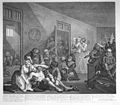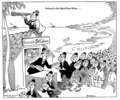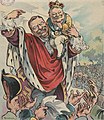The Cartoon Portal

A cartoon is a type of visual art that is typically drawn, frequently animated, in an unrealistic or semi-realistic style. The specific meaning has evolved, but the modern usage usually refers to either: an image or series of images intended for satire, caricature, or humor; or a motion picture that relies on a sequence of illustrations for its animation. Someone who creates cartoons in the first sense is called a cartoonist, and in the second sense they are usually called an animator.
The concept originated in the Middle Ages, and first described a preparatory drawing for a piece of art, such as a painting, fresco, tapestry, or stained glass window. In the 19th century, beginning in Punch magazine in 1843, cartoon came to refer – ironically at first – to humorous artworks in magazines and newspapers. Then it also was used for political cartoons and comic strips. When the medium developed, in the early 20th century, it began to refer to animated films that resembled print cartoons. (Full article...)

In print media, a cartoon is a drawing or series of drawings, usually humorous in intent. This usage dates from 1843, when Punch magazine applied the term to satirical drawings in its pages,[1] particularly sketches by John Leech.[2] The first of these parodied the preparatory cartoons for grand historical frescoes in the then-new Palace of Westminster in London.[3]

Sir John Tenniel—illustrator of Alice's Adventures in Wonderland—joined Punch in 1850, and over 50 years contributed over two thousand cartoons.[4]
Selected article -
The Jyllands-Posten Muhammad cartoons controversy began after 12 editorial cartoons, most of which depicted the Islamic prophet Muhammad, were published in the Danish newspaper Jyllands-Posten on 30 September 2005. The newspaper announced that this publication was an attempt to contribute to the debate regarding criticism of Islam and self-censorship. Danish Muslim organizations that objected to the depictions responded by holding public protests attempting to raise awareness of Jyllands-Posten's publication. Further examples of the cartoons were soon reprinted in newspapers in more than 50 other countries, further deepening the controversy. This led to Islamic protests across the Muslim world, some of which escalated into violence with instances of firing on crowds of protestors resulting in a total of more than 100 reported deaths, including the bombing of the Danish embassy in Pakistan and setting fire to the Danish Embassies in Syria, Lebanon and Iran, storming European buildings, and burning the Danish, Dutch, Norwegian, French and German flags in Gaza City. Various groups, primarily in the Western world, responded by endorsing the Danish policies, including "Buy Danish" campaigns and other displays of support. Danish Prime Minister Anders Fogh Rasmussen described the controversy as Denmark's worst international crisis since World War II. Critics of the cartoons described them as Islamophobic or racist, and argued that they are blasphemous to people of the Muslim faith, are intended to humiliate a Danish minority, or are a manifestation of ignorance about the history of Western imperialism. Supporters have said that the cartoons illustrated an important issue in a period of Islamic terrorism and explained that their publication is a legitimate exercise of the right of free speech, explicitly tied to the issue of self-censorship. They explained that Muslims were not targeted in a discriminatory way, since unflattering cartoons about other religions (or their leaders) are frequently printed. They question whether some of the riots were spontaneous outpourings as they took place where no spontaneous demonstrations are allowed, and whether the images of Muhammad per se are offensive to Muslims, as thousands of illustrations of Muhammad have appeared in books by and for Muslims.
Selected character -
Anarky is a fictional character in the DC Comics Universe. Co-created by Alan Grant and Norm Breyfogle, he first appeared in Detective Comics #608 (November 1989) as an adversary of Batman. Stories revolving around Anarky often focus on political and philosophical themes. Named after the philosophy of anarchism, the primary philosophical element that has underscored the character's appearances has been anti-statism. With Grant's transition to the philosophy of Neo-Tech, Anarky was transformed from a vehicle for socialist and populist philosophy, to rationalist, atheist, and free market based thought. Inspired by multiple sources, early stories to feature the character often included homages to political and philosophical books. The creation of the character was also partially influenced by Alan Moore's character "V" from V for Vendetta. Originally intended to only be used in the debut story in which he appeared, positive reception by readers and his editor convinced Grant to continue using Anarky as a recurring character throughout the early 90s. This popular acclaim culminated, however, in a financially and critically unsuccessful ongoing solo series. The 1999 Anarky series, in which even Alan Grant has expressed his distaste, was quickly canceled after eight issues.
Did you know... -
- ...that Star Trek: Countdown, a comic book prequel to the 2009 film Star Trek, is also a sequel to the 2002 film Star Trek Nemesis?
- ...that the Fire Nation, from the Universe of Avatar: The Last Airbender, was inspired by photos of volcanic islands of Iceland and the Pacific Ocean?
- ...that the Sam Sheepdog and Ralph Wolf cartoons Sheep Ahoy, A Sheep in the Deep, and Don't Give Up the Sheep were censored by ABC to remove a dynamite stick, a smoke break scene, and a spanking scene respectively?
Selected list -
The episodes of The Simpsons, an American animated sitcom, created by Matt Groening (pictured) for the Fox Broadcasting Company. The series is a satirical parody of a middle class American lifestyle epitomized by its eponymous family, which consists of Homer, Marge, Bart, Lisa, and Maggie. The show is set in the fictional town of Springfield, and lampoons American culture, society and television, and many aspects of the human condition. Groening created a dysfunctional family and named the characters after members of his own family, substituting Bart for his own name. Since its debut on December 17, 1989, The Simpsons has broadcast 781 episodes. The Simpsons holds several American television longevity records. It is the longest-running prime time animated series and longest-running sitcom in the United States. The series has surpassed Gunsmoke in seasons to claim the spot as the longest-running American prime-time scripted television series.
General images -
Selected biography -
Lat is a Malaysian cartoonist whose work earned him the honorific title of datuk. He was born on 5 March 1951 in a village in Perak, Malaysia, and started supplementing his family's income at the age of nine by submitting his comics to magazines and newspapers. Four years later, he published his first comic book. In 1970, Lat left school and became a crime reporter while continuing his cartooning sideline. His comic about the Bersunat—a circumcision ceremony all Malaysian boys of the Islamic faith have to undergo—made a great impression on his newspaper's editor-in-chief. As a result, Lat became an editorial cartoonist. As he gained popularity through his cartoons in Malaysia, he published his autobiography in the form of two graphic novels—The Kampung Boy and Town Boy. The Kampung Boy was a huge success and gained him international renown. It is published in various countries around the world in several languages. Lat's cartoons provide an unbiased and humorous insight on the lives and culture of Malaysians, who consider him one of their most trustworthy citizens. His admirers include American cartoonists Sergio Aragonés and Matt Groening.
Subcategories
WikiProjects
- Main projects
- Arts • Animation • Comics • Entertainment • Visual arts
- Related Projects
- Anime and manga • Biography • Film • Fictional characters • Media franchises • Music • Television • Video games
Selected quote -
Topics
- Comic book
- Comic strip
- Digital comics
- Graphic novel
- Mobile comic
- Motion comics
- Trade paperback
- Webcomic
- Animator
- Animation director
- Animation studios
- Animation film festivals
- Feature-length films
- Short films
- Television series
- Computer-animated films
- Stop-motion films
- Traditional animation
- Limited animation
- Rotoscoping
- Stop Motion
- Clay
- Cutout
- Graphic
- Model
- Object
- Pixilation
- Puppetoon
- Computer animation
- Flash animation
- PowerPoint animation
- SVG animation
- Cel-shaded animation
- Crowd simulation
- Morph target animation
- Motion capture
- Non-photorealistic rendering
- Skeletal animation
Things you can do

- Requested articles: Fenwick (comics), Khimaera (comics), Mutant Underground Support Engine, Bruce J. Hawker, Marc Dacier, Hultrasson, Frankenstein Comics, Dave Johnson (comics), Paco Medina, Dappere Dodo, New Adventures of the Space Explorers, Habatales, Musical Box, Foo-Foo (TV series), Bonne nuit les petits, The Adventures of Lariat Sam, More...
- Images and photos needed: Request images that are needed from Wikipedia requested images of comics and animation to included in each articles.
- Stubs: Work on stubs in articles in Comics and Animation stubs.
- Infobox: Add infobox that are needed from Category:Comics articles without infoboxes and Category:Animation articles needing infoboxes in articles.
- Deletion sorting: Please see the collection of discussions on the deletion of articles related to comics and animation - compiled by WikiProject Deletion sorting
Related portals
Associated Wikimedia
The following Wikimedia Foundation sister projects provide more on this subject:
-
Commons
Free media repository -
Wikibooks
Free textbooks and manuals -
Wikidata
Free knowledge base -
Wikinews
Free-content news -
Wikiquote
Collection of quotations -
Wikisource
Free-content library -
Wikiversity
Free learning tools -
Wiktionary
Dictionary and thesaurus
More portals
Sources
- ^ Punch.co.uk. "History of the Cartoon". Archived from the original on 2007-11-11. Retrieved 2007-11-01.
- ^ Adler & Hill 2008, p. 30.
- ^ "Substance and Shadow: Original Editorial Accompanying "Cartoon, No. I"". Victorian web.org. Retrieved 29 October 2023.
- ^ "Sir John Tenniel". National Portrait Gallery. Retrieved 26 August 2022.






































